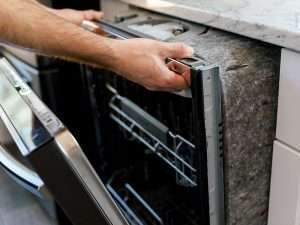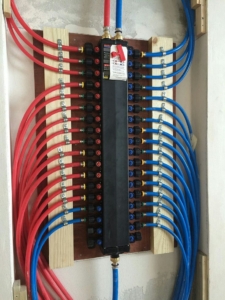A Guide to Changing Your Faucet Aerator

The faucet aerator is a small but vital component of your bathroom or kitchen sink. It helps regulate water flow, reduce splashing, and conserve water. Over time, aerators can become clogged or worn out, requiring replacement. Don’t worry if you’re new to DIY projects; changing a faucet aerator is a relatively easy task that you can tackle on your own. In this blog, we’ll provide you with a step-by-step guide on how to change your faucet aerator and restore optimal water flow.
How to replace a Faucet Aerator
Step 1: Gather the Necessary Tools:
Before you begin, gather the following tools and materials:
– New faucet aerator (ensure it matches your faucet model)
– Adjustable wrench or pliers (channel locks)
– Plumbing tape (Teflon tape)
– Cloth or masking tape (to protect the aerator finish)
Step 2: Shut Off the Water Supply:
To prevent any unwanted leaks, turn off the water supply to your faucet. Locate the shut-off valves under the sink and turn them clockwise to close. If you can’t find individual shut-off valves, shut off the main water supply to your house.
Step 3: Remove the Existing Aerator:
Find the aerator at the end of your faucet. Wrap a cloth or masking tape around the aerator to protect its surface. Use an adjustable wrench or pliers to grip the aerator firmly. Rotate the aerator counterclockwise to loosen and unscrew it from the faucet. Apply moderate force, being cautious not to damage the faucet or other components.
Step 4: Clean the Faucet Tip:
After removing the old aerator, inspect the faucet tip for any debris or mineral buildup. Use an old toothbrush or a small brush to gently scrub away any dirt or deposits. Rinse the faucet tip thoroughly with water to ensure it’s clean and ready for the new aerator.
Step 5: Prepare the New Aerator:
Take your new faucet aerator out of its packaging and examine the components. Some aerators may come with additional washers or adapters for proper installation. Consult the manufacturer’s instructions to determine if any extra pieces are required. Attach any provided washers or adapters securely to the new aerator.
Step 6: Apply Plumbing Tape:
To prevent potential leaks, wrap several clockwise turns of plumbing tape (Teflon tape) around the threaded portion of the faucet tip. This tape acts as a sealant when you install the new aerator.
Step 7: Install the New Aerator:
With the plumbing tape in place, screw the new aerator onto the faucet tip by hand. Ensure it aligns properly with the threads. Then, use the adjustable wrench or pliers to tighten it gently. Avoid overtightening, as it may damage the aerator or make future removal difficult.
Step 8: Turn on the Water Supply:
Now that you have installed the new aerator, it’s time to turn on the water supply. Gradually open the shut-off valves or the main water supply, allowing water to flow into the faucet. Keep an eye out for any leaks around the aerator. If you notice any, use the wrench or pliers to tighten the aerator slightly until the leaking stops.
Step 9: Test and Adjust:
Turn on the faucet to check the water flow and ensure it’s running smoothly through the new aerator. Observe if the aerator is providing the desired stream pattern and minimizing splashing. If necessary, you can make further adjustments by removing the aerator and adjusting the flow restrictor or trying a different aerator model.
How to Clean A Faucet Aerator
Cleaning a faucet aerator is a simple process that can help restore optimal water flow and prevent clogs. Here’s a step-by-step guide on how to clean a faucet aerator:
1. Start by turning off the water supply to the faucet. Locate the shut-off valves under the sink and turn them clockwise to close.
2. Once the water supply is turned off, locate the aerator at the end of the faucet. It is usually a small mesh screen or a cap with holes.
3. Use a cloth or masking tape to protect the aerator’s surface from scratches. Grip the aerator firmly with your hand and twist it counterclockwise to remove it from the faucet.
4. Inspect the aerator for any debris or mineral buildup. You may notice sediment, limescale, or other particles clogging the mesh screen or the holes.
5. To clean the aerator, you can soak it in a solution of vinegar and water. Mix equal parts of white vinegar and water in a bowl or container, and submerge the aerator in the solution. Let it soak for 15-20 minutes to dissolve any mineral deposits.
6. After soaking, use a small brush, such as an old toothbrush, to scrub the aerator gently. Pay attention to the mesh screen or holes, making sure to remove any remaining debris.
7. Rinse the aerator thoroughly with clean water to remove any vinegar residue or loosened particles.
8. Before reinstalling the aerator, it’s a good idea to flush the faucet by briefly turning on the water supply to remove any loose debris.
9. Screw the clean aerator back onto the faucet by hand, turning it clockwise. Ensure it aligns properly and then use your hand to tighten it gently.
10. Once the aerator is securely in place, turn on the water supply and check for any leaks. If necessary, use pliers or an adjustable wrench to tighten the aerator slightly.
By following these steps, you can effectively clean your faucet aerator and maintain smooth water flow. Regular cleaning of the aerator will help prevent clogs and ensure the efficient functioning of your faucet.
Here are 10 frequently asked questions about faucet aerators along with their answers:
1. What is a faucet aerator, and what does it do?
– A faucet aerator is a device that screws onto the end of a faucet, adding air to the water flow. It helps reduce splashing, improve water pressure, and conserve water by limiting the flow rate.
2. How does a faucet aerator conserve water?
– Faucet aerators mix air with the water stream, reducing the volume of water used while maintaining the perception of a steady flow. This helps conserve water without compromising functionality.
3. Can I install a faucet aerator on any type of faucet?
– In most cases, yes. Faucet aerators are available in different sizes and thread types to fit various faucet models. However, it’s recommended to check the specific aerator compatibility with your faucet before installation.
4. How often should I clean or replace my faucet aerator?
– It is advisable to clean or inspect your faucet aerator at least once every few months. However, if you notice reduced water flow or sediment buildup, it may need cleaning or replacement sooner.
5. Are there different types or sizes of faucet aerators?
– Yes, there are various types and sizes of faucet aerators available. The standard sizes are typically measured in gallons per minute (GPM), such as 1.5 GPM or 2.2 GPM. Additionally, there are aerators designed for specific purposes, such as those with adjustable spray patterns or dual-function aerators.
6. How do I choose the right aerator for my faucet?
– To choose the right aerator, consider the thread type and size of your faucet. It’s also important to determine the desired flow rate and any additional features you may prefer, such as a swivel function or spray patterns.
7. Can a faucet aerator improve water pressure?
– Yes, a faucet aerator can help improve water pressure by mixing air with the water stream, creating a more efficient flow. However, if your water pressure is already low, a higher flow rate aerator might be more suitable.
8. Are there any special considerations for installing an aerator in a kitchen versus a bathroom faucet?
– Generally, the process of installing an aerator is similar for both kitchen and bathroom faucets. However, the flow rate requirements and aerator sizes may vary. Kitchen faucets typically have higher flow rates and larger aerators compared to bathroom faucets.
9. What are the benefits of using a low-flow or water-saving aerator?
– Low-flow or water-saving aerators reduce water consumption by restricting the flow rate. They can help lower utility bills, conserve water resources, and promote environmental sustainability without sacrificing functionality.
10. How do I remove a stubborn or stuck aerator from my faucet?
– If the aerator is stuck, try using pliers or an adjustable wrench with a cloth or tape wrapped around the aerator to protect its finish. Apply gentle, steady pressure in a counterclockwise direction to unscrew and remove it. If it remains stuck, you may need to use a penetrating lubricant or seek professional assistance.
Remember, if you have specific concerns or unique faucet configurations, it’s always best to consult the manufacturer’s instructions or seek professional advice.
Summary:
Changing your faucet aerator is a simple task that can greatly enhance water efficiency and overall performance. By following this step-by-step guide, you can successfully replace your old aerator with a new one, restoring optimal water flow and minimizing wastage. Remember to choose a compatible aerator, use the right tools, and exercise caution during the process. With a little effort, you’ll have a functional and efficient faucet that saves water and improves your daily sink experience.






